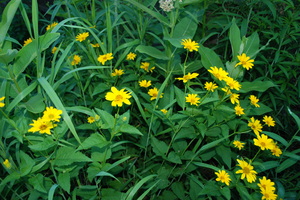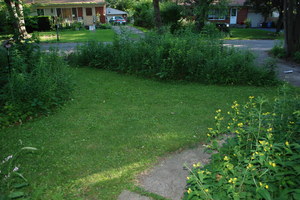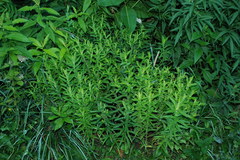Is it a weed patch, or a garden? 'Cues to care' clue in neighbors, passersby

False sunflower (Heliopsis helianthoides) brings some bright color to my yard.
Rick Meader | Contributor
Instead, try to do little things with your landscape that will let your neighbors or passersby know that you haven’t just let your lawn “go to seed” and that there’s a method behind the madness.
Joan Nassauer, a professor of mine in Landscape Architecture at the University of Michigan, taught us about the value in “cues to care”. Basically, “cues to care” are things you can do with a landscape that let people know that you are actually caring for it. These cues can be formal, casual, functional or humorous. They can be big or small, but they have to be noticeable to a casual observer, or you’re just doing it for yourself. This concept works for yards with a pocket of native landscaping or for yards that are mostly or all “wild.” For example, my front yard is not big, and was a traditional mostly rectangular lawn with a strip of mainstream landscaping along the side. I gradually took some of the lawn area out of mowing, replacing it with native plants that like woods. Our little house looks a little like a cottage, and we have a lot of trees on our lot, so I decided to work toward a “cottage in the woods” look by adding plants that could utilize the light shade. As I learned more about the trees in my yard, I found that about 80 percent of them are invasive - Siberian elm and White mulberry. In any case, they cast a nice light shade that worked with the cottage theme. This is all a painful background to the point of my story. As I got more plants, I needed more room, so I took more area out of lawn. I kind of went with a rounded edge look to the woodland plantings instead of just the geometric look. In order to really give it a defined edge, and let people know that I meant for it to be there, I got a pallet of bricks and used it to edge the woodland plantings. This edging is a cue to care. I could have used rocks, or fencing, or even a cut edge, but by showing a definite edge between the plantings and the lawn, it lets people know that there is intent in the design. Of course, mowing the lawn that remains also helps.

Brick edging "cue to care" separates the taller native plants from my lawn. It needs some trimming to really show off the bricks.
Rick Meader | Contributor
Other cues to care can include bird feeders, bird baths, clever little signs, definite patterns in the plantings, a defined trail through the “wild” area that could be brick, stone, pavers or even wood chips and little signs identifying the plants. I tried this with little black stones that I painted the scientific name on, but as the plants got taller, you couldn’t see the stones, so I gave that one up. If I had used signs on taller stakes, that could have been a valid cue, but as I accumulated more than 75 species, that could get a bit ridiculous in appearance.
Another way you can clue people in to the fact that you actually want your yard to look the way it does is to plant a lot of flowering plants. People like flowers, even ones they don’t know (and hopefully ones that don’t look like dandelions). If you have a disproportionate number of plants with attractive flowers, you have a better chance of people liking it. Also, if you have plants that don’t flop over a lot, that helps. People like structure, and people that don’t appreciate the casual beauty of a prairie or meadow don’t get the graceful beauty of flopping plants. I don’t propose gardening just to please those who stick with short, non-native, straight-as-a-ruler plantings, but you can bend just a bit to increase the acceptance of your garden, the use of native plants in general.
Another way I was taught by Bill Schneider of Wildtype Nursery to reduce the floppiness of some flowering plants and still get the benefit of their flowering beauty is to bring out the shears. Late summer and fall bloomers that can get tall enough to flop over can benefit from a shearing in June. If you cut them down to half their height in June, you’ll still get the fall blooms, but the plant will be more like a 3-foot blooming bush than a 5-foot flowing fountain of color. It won’t work with the spring or early summer perennials because you may be cutting off the flower buds, but it works very well on the asters (New England and Smooth Aster) I’ve cut down to size.

New England Aster (Aster novae-angliae) with its summer haircut. Lopping off about a foot in June will make for a bushier, less gangly fall blooming display.
Rick Meader | Contributor
Have a great week, and enjoy nature everyone!
Rick is a local landscape architect with a special interest in all things natural, including native plants and the critters that eat them. You can contact him at yourland1824@gmail.com.


Comments
Rick Meader
Mon, Jul 5, 2010 : 10:09 p.m.
Thanks for your comment, Rork (and for your comments on my other entries). I haven't cut back my ironweed either, but that's mainly because they're at the back of my garden. They get to be 6 feet tall there, but only 3' tall in my front, shadier garden. Liatris are great, and make great photo partners with feeding butterflies. Rick
Rork Kuick
Fri, Jul 2, 2010 : 8:18 a.m.
Yeah, I should have shortened my ironweed (maybe it's Vernonia fasciculata - these asters can be tricky) earlier. Now its 6 feet tall but has flower buds already. In the wild it usually grows in such difficult and sunny places that it stays shorter. My dense blazing star (Liatris spicata) is on, but I am playing with the much later blooming rough blazing star (Liatris aspera) which I have seen a few people in town have - and I was shocked. Aspera actually likes high and dry in the wild, quite the opposite of where I see spicata. I feel honored to encounter either.